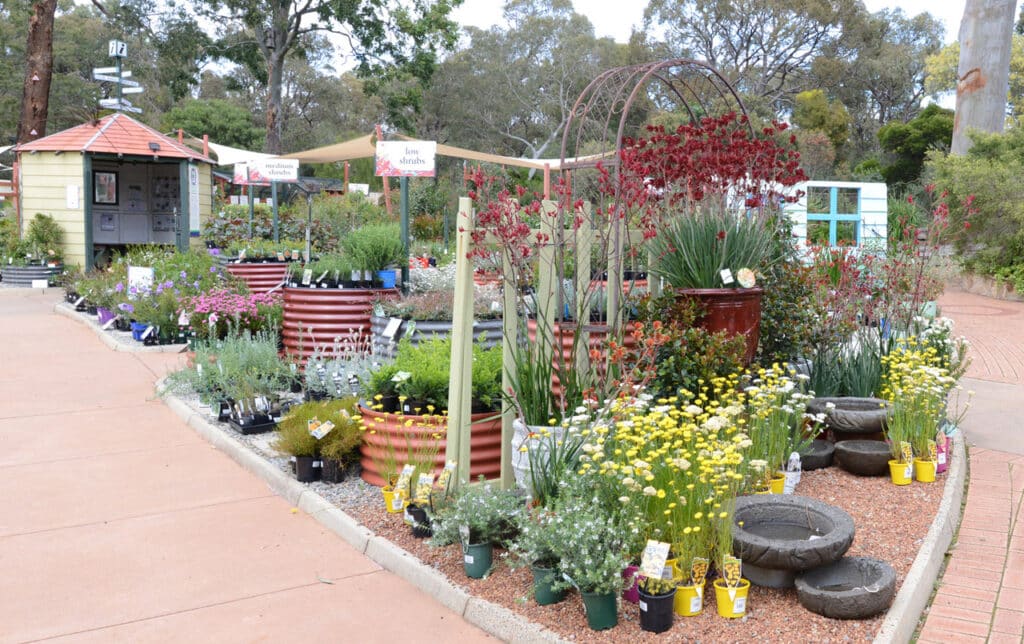Menu
Opening Hours: 9am-5:30pm, Every day except closed on Christmas Day and Boxing Day.
Opening Hours: 9am-5:30pm, Every day except closed on Christmas Day and Boxing Day.

Selecting Your Plants
Australian plants are diverse – each has a different set of requirements for successful cultivation.
• There are Australian plants that tolerate extreme drought, others can grow in wet, boggy situations.
• There are some which require full sun, others which prefer or tolerate shade.
• There are plants which do well in heavy clay, others which prefer the deep, infertile sands of the Perth plains. When planning your garden, it is important to check the requirements of your selected plants by using reference books or the Zanthorrea Nursery Plant List. If in doubt, our friendly staff may be contacted by phone. When choosing a location for your plant, consider sun or shade, aspect (north, south, east or west), wind speed and direction, and frost. Remember, when planting under eaves you will need to water in winter!
Prepare the Soil Well for Growth
Perth conditions may be roughly divided into two ‘challenges’; the sandy, infertile soils of the Perth coastal plain, and the heavy, gravelly or clay soils found in the hills. In both cases, improving the planting hole will assist the new plant, either by holding the water around the tender roots in sandy soils, or providing aeration through hard clay soils.
Can I Plant All Year Round?
Yes! As long as you water your new plants, planting can take place all year round. Plant your new plants as soon as possible after purchase. If you do not intend to plant them straight away, keep them together in a lightly shaded spot and water daily over summer. A sunny spot is best in winter.
Successful Planting
The cool of evening is best for planting, but early morning will do. Always water the plants before planting to ensure easy removal from the pot
Dig a hole, allowing 20cm clearance around the plant, wider in clay and deeper in sand. Water both
the plant and the soil before you start. (You may choose to have the hose gently running into the planting hole as you go!)
2. Compost
Toss in about 2 litres of good compost or soil improver, and stir into the soil, deeper into sand and wider into clays.
3. Remove Gently
With your fingers over the soil surface, hold the pot upside-down and tap gently against a hard surface to remove the plant. It is not advisable to tease out the roots unless they are tightly coiled. If roots form a solid mass around the edge of the pot ball, a shallow knife incision may be made vertically down both sides to ensure the plant is not rootbound.
4. Fertiliser (optional)
Add to the hole a teaspoon of slow release fertiliser, and place plant on top, ensuring that its surface matches the soil level of the surrounds. In sandy soils, you may place the plant 1cm below the soil
surface and create a shallow basin to allow water to drain towards the new plant.
5. Backfill and Water Well
Backfill around the shrub with the remaining soil and gently firm in by hand. Water the new plant
with about a bucketful of water to ensure all air pockets are removed and the plant is well settled in. If necessary in windy locations, place a stake next to trees and use a soft tie in a figure of eight to hold in place.
6. Aftercare
Once your beautiful new plant is in situ, it still requires some care.
Water: When planting in summer, it is essential to water the new plant every day for a month, and then gradually wean off the watering until the winter rains. When planting in winter, many Australian native plants will survive with little or no water. However, for a healthy glorious garden full of flower, regular water over summer is recommended. Water deeply at weekly or fortnightly intervals once the plant is established. Some plants need more regular water- check on the label.
Mulch
Mulch will conserve precious moisture and prevent runoff, as well as keep the weeds at bay. Mulches also keep the soil temprerature cooler in summer and warmer in winter. Organic mulch has the added advantage that it slowly breaks down to provide nutrients to the plant. (Examples are woodchip or tree-prunings.) This type of mulch may need topping up every two years. Fine gravel and coarse river sand make an adequate mulch and do not break down. When applying organic mulches, take care that the mulch does not build up against the stem of the plant as it may cause stem rot.
Fertilising
Australian native plants generally do not require fertiliser once established, however a light application of a low phosphorous fertiliser will ensure healthy growth and build disease and pest resistance.
• Some Australian plants grow naturally in fertile areas such as rainforests. These will, of course, require more regular fertiliser, e.g Native frangipani and Illawarra flame tree. Some just seem to grow best with a little feeding, e.g Bottlebrush and hybrid kangaroo paws.
• Other natives, especially those from drier areas, may object to fertiliser, so take care. E.g darwinea, boronia, eremophila.
Pruning
Light pruning after flowering will result in an increased numbers of flowers next season. Regular trimming will reduce woodiness which is common in Australian plants such as Bottlebrush, melaleucas and leptospermums. Tropical grevilleas may be hard pruned every five years or so, to stimulate lush growth and masses of blooms. Always use clean, sharp secateurs and saws to avoid bruising. Late summer is a good time for drastic pruning, but light pruning may be carried out all year round. With a little care and attention, your Australian native garden will provide you with hours of pleasure and create a pleasant oasis and refuge for local wildlife.
We love your feedback, please review us on Google

“Zanthorrea Nursery has been an accredited nursery and garden centre for many years, and is active in supporting Greenlife Industry Australia and the Nursery and Garden Industry of WA”
